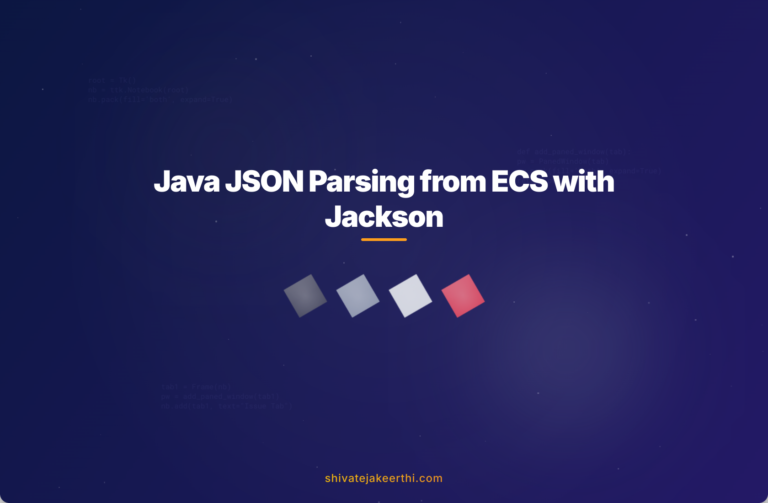Reading and parsing JSON data stored in Elastic Cloud Storage (ECS) using Java is a common scenario for developers, especially when building scalable, cloud-enabled apps. JSON, being a lightweight and universal data interchange format, fits perfectly into diverse programming environments. Java developers often need robust solutions for efficiently reading JSON files from cloud storage services like ECS and converting that JSON data into Java objects for easy use within applications.
Overview of JSON Files
JSON JavaScript Object Notation is a popular, text-based data interchange format. It stores data as key-value pairs, making it human-readable as well as machine-friendly.
Developers prefer JSON files over more verbose formats like XML primarily because JSON is lightweight, easier to parse, and widely supported by multiple programming languages. You’ll see JSON often when dealing with APIs, configurations, or data transfer between different systems.
Its flexibility and simplicity have led JSON to become the de-facto standard for web development, particularly in JavaScript applications.
Reading JSON File from ECS (Elastic Cloud Storage)
Elastic Cloud Storage (ECS) provided by EMC Dell is scalable, reliable object storage similar to AWS S3. It’s ideal for storing and fetching large amounts of unstructured data, such as JSON files.
Accessing JSON stored in ECS using Java involves a few straightforward steps:
- Setting up credentials and endpoint configurations to connect ECS.
- Specifying the JSON file location using a unique URI (Uniform Resource Identifier).
- Using an ECS-compatible Java SDK or AWS SDK (because ECS supports the S3 protocol).
- Retrieving the JSON file and converting it into a readable Java stream format (like ResponseInputStream).
Since ECS adheres to the Amazon S3 API, you can comfortably use tools like Amazon’s AWS Java SDK for working with ECS data as well.
Converting JSON Data to Java Objects
Once you have your JSON file retrieved, you must convert it from raw data into structured Java objects for easy use within your application logic. This conversion has several benefits:
- Simplified coding: Java objects provide intuitive and type-safe access to data.
- Easy manipulation: You can leverage Java methods and loops to manipulate JSON data once it’s converted to Java objects.
- Robustness: Java object mapping assures data integrity and readability.
Usually, you’ll create Java classes known as POJOs (Plain Old Java Objects), and these classes represent a clear mapping of JSON keys to Java object fields. Libraries such as Jackson or Gson help in converting JSON to Java objects quickly and efficiently.
Example JSON File Format
For a demo, let’s imagine a simple JSON file that contains names stored in ECS:
[
{ "name": "John", "lastName": "Smith" },
{ "name": "Emma", "lastName": "Johnson" },
{ "name": "James", "lastName": "Williams" }
]
This structure will simplify the demonstration of reading data and mapping it to Java classes.
Java Code for Reading JSON from ECS (via S3 API)
Here’s how you might set up Java code that uses AWS SDK to connect seamlessly with ECS and fetch the JSON:
import software.amazon.awssdk.auth.credentials.AwsBasicCredentials;
import software.amazon.awssdk.auth.credentials.StaticCredentialsProvider;
import software.amazon.awssdk.regions.Region;
import software.amazon.awssdk.services.s3.S3Client;
import software.amazon.awssdk.services.s3.model.GetObjectRequest;
import software.amazon.awssdk.services.s3.model.GetObjectResponse;
import software.amazon.awssdk.core.ResponseInputStream;
public class ECSJsonReader {
public static void main(String[] args) {
AwsBasicCredentials creds = AwsBasicCredentials.create("your-access-key", "your-secret-key");
S3Client s3 = S3Client.builder()
.credentialsProvider(StaticCredentialsProvider.create(creds))
.region(Region.US_EAST_1)
.endpointOverride(URI.create("https://ecs.your-domain.com"))
.build();
GetObjectRequest objectRequest = GetObjectRequest.builder()
.bucket("your-bucket")
.key("names.json")
.build();
ResponseInputStream jsonContent = s3.getObject(objectRequest);
// Now jsonContent stream is ready for parsing
}
}
Replace endpoint, access keys, and bucket name with your ECS storage parameters.
Printing JSON Data to the Console
Typically, before the actual parsing, you’d first output the JSON to visually ensure your file was correctly retrieved:
BufferedReader reader = new BufferedReader(new InputStreamReader(jsonContent));
reader.lines().forEach(System.out::println);
Analyzing JSON data visually in the console is always a beneficial step to validate correctness before committing to conversion logic.
Creating a List of Java Objects
To store the JSON data in Java, define a simple POJO class called Name:
public class Name {
private String name;
private String lastName;
public String getName() {
return name;
}
public void setName(String name) {
this.name = name;
}
public String getLastName() {
return lastName;
}
public void setLastName(String lastName) {
this.lastName = lastName;
}
}
Next, parse this JSON data into a List collection using Jackson:
import com.fasterxml.jackson.core.type.TypeReference;
import com.fasterxml.jackson.databind.ObjectMapper;
ObjectMapper mapper = new ObjectMapper();
// Parse JSON stream into List
List<Name> namesList = mapper.readValue(jsonContent, new TypeReference<List<Name>>(){});
// Now your JSON data is successfully mapped into a Java List of Name objects!
for(Name entry : namesList) {
System.out.println(entry.getName() + " " + entry.getLastName());
}
Why Use Lists in Java?
Storing data in a List structure gives you tremendous flexibility:
- Dynamic data size: Lists handle varying amounts of data with ease.
- Efficient Processing: Easily traverse, update, or manipulate stored objects.
- Built-in Functionality: Java’s List interface provides helpful methods that save time coding mundane tasks.
Keep performance considerations in mind, and remember that lists offer exceptional readability and maintainability in most real-world applications.
Taking JSON from ECS, converting it to objects, and storing it in a flexible data structure significantly streamlines your Java programming. It’s a common and practical solution for applications in many industries, from large-scale distributed systems to straightforward web projects.
How might you apply JSON storage and object conversion in your current Java project? Let us know your thoughts and scenarios!



0 Comments